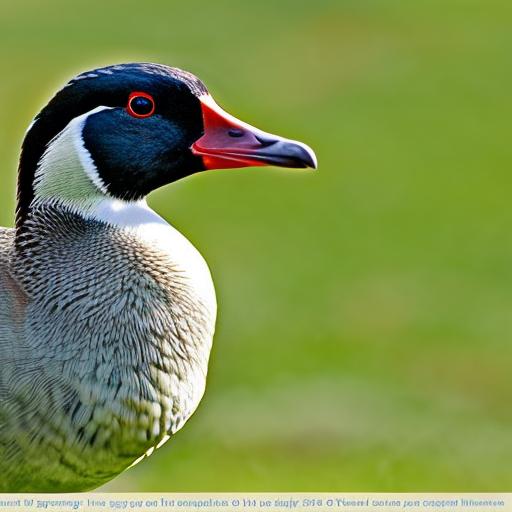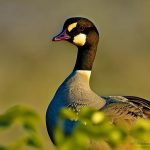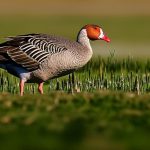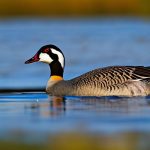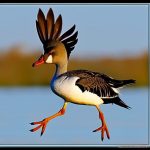Canadian geese invading lawns has become a common problem in many areas. These large birds can cause damage to lawns, leave behind droppings that are unsightly and unsanitary, and can be aggressive towards humans and pets. It is important for homeowners to find effective deterrents to keep geese away from their property. In this article, we will explore various methods for deterring Canadian geese from lawns, including physical barriers, decoys, motion-activated sprinklers, noise deterrents, unappealing vegetation, removing food sources, reflective tape or balloons, seeking professional wildlife control services, and working with the local community.
Key Takeaways
- Canadian geese are attracted to open spaces with easy access to water and food sources.
- Creating a physical barrier around your lawn can prevent geese from entering and damaging your property.
- Using decoys, such as fake predators or other geese, can deter geese from landing on your lawn.
- Installing motion-activated sprinklers can startle geese and discourage them from returning to your lawn.
- Using noise deterrents, such as loud noises or predator calls, can also keep geese away from your property.
Understanding the behavior of Canadian geese
To effectively deter Canadian geese from your lawn, it is important to understand their habits and behaviors. Canadian geese are migratory birds that are attracted to open areas with grassy lawns and bodies of water. They are social animals that often travel in large flocks and can be territorial during nesting season. They are also known for their strong homing instinct, which means they will return to the same area year after year if they find it suitable.
Canadian geese are difficult to deter because they are adaptable and intelligent. They can quickly learn to avoid certain areas or adapt to new deterrents. They are also persistent and will continue to return to an area if they find it attractive. Additionally, Canadian geese have a strong sense of community and will often follow the lead of other geese in their flock. This means that if one goose finds a lawn attractive, others are likely to follow.
Creating a physical barrier around your lawn
One effective method for deterring Canadian geese from your lawn is to create a physical barrier. This can be done using fences or netting. The benefits of physical barriers are that they create a clear boundary between your lawn and the geese, preventing them from accessing the area. Fences should be at least 3 feet high and made of materials that are difficult for geese to climb or fly over. Netting can be used to cover areas such as ponds or other bodies of water to prevent geese from landing.
When installing a physical barrier, it is important to ensure that it is secure and well-maintained. Geese are persistent and will try to find ways around or through the barrier. Regularly inspect the fence or netting for any damage or gaps that need to be repaired. Additionally, it may be necessary to install additional deterrents such as spikes or wires on top of the fence to prevent geese from perching on it.
Using decoys to deter geese from your lawn
Another method for deterring Canadian geese from your lawn is to use decoys. Decoys can be in the form of fake predators, such as plastic owls or coyotes, or other animals that geese find threatening. The effectiveness of decoys depends on how realistic they look and how frequently they are moved around. Geese are intelligent and can quickly learn that a decoy is not a real threat if it remains in the same location for an extended period of time.
To use decoys effectively, it is important to move them around regularly. This will create the illusion of movement and make the decoy appear more realistic. Additionally, consider using multiple decoys in different locations to create the impression of a larger threat. It is also important to regularly clean and maintain the decoys to ensure they remain effective.
Installing motion-activated sprinklers
Motion-activated sprinklers can be an effective deterrent for Canadian geese. These sprinklers are triggered by movement and spray water in the direction of the movement, scaring away geese and other animals. The benefits of motion-activated sprinklers are that they provide a consistent and automatic deterrent, and they can cover a large area.
When installing motion-activated sprinklers, it is important to strategically place them in areas where geese are likely to land or gather. This may include near bodies of water or open areas of grass. It is also important to adjust the sensitivity of the sprinklers to ensure they are triggered by the movement of geese, but not by other animals or objects such as falling leaves. Regularly check and maintain the sprinklers to ensure they are functioning properly.
Using noise deterrents to keep geese away
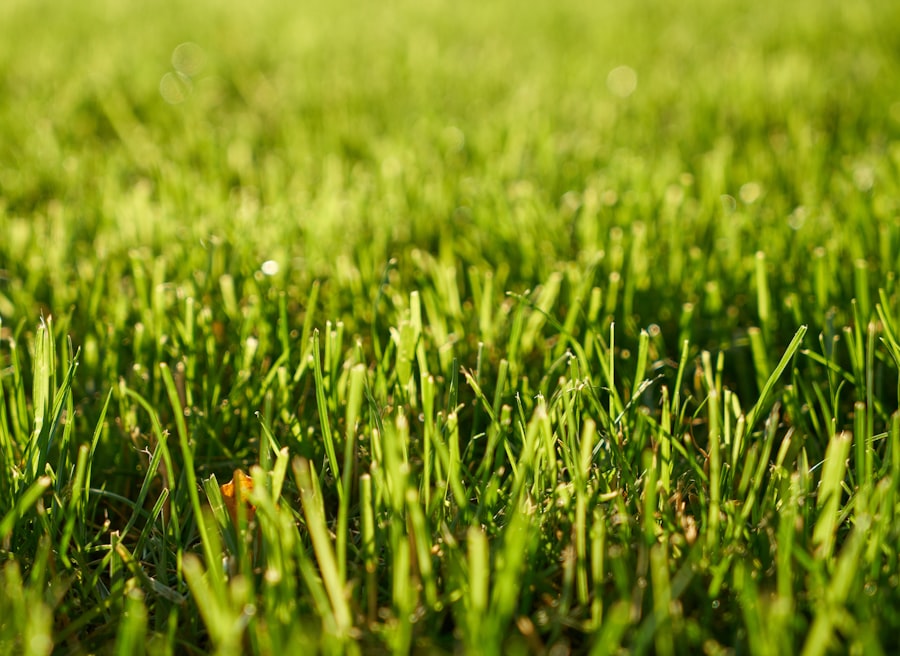
Noise deterrents can be an effective method for keeping Canadian geese away from your lawn. Loud noises or alarms can startle geese and make them feel threatened, causing them to leave the area. There are various noise deterrents available, including devices that emit loud sounds or alarms, as well as homemade solutions such as banging pots and pans together.
To use noise deterrents effectively, it is important to place them strategically in areas where geese are likely to gather or land. This may include near bodies of water or open areas of grass. It is also important to vary the type and intensity of the noise deterrents to prevent geese from becoming accustomed to a specific sound. Regularly check and maintain the noise deterrents to ensure they are functioning properly.
Planting unappealing vegetation around your lawn
Planting unappealing vegetation around your lawn can be an effective method for deterring Canadian geese. Geese prefer open areas with short grass where they can easily spot predators and access food sources. By planting tall grass, thorny bushes, or other types of vegetation that geese find unappealing, you can make your lawn less attractive to them.
When choosing vegetation for your lawn, consider plants that are native to your area and are known to be unappealing to geese. These may include plants with thorns or prickly leaves, as well as tall grasses or shrubs that provide cover and make it difficult for geese to spot predators. It is important to regularly maintain and trim the vegetation to ensure it remains unappealing to geese.
Removing any food sources near your lawn
Canadian geese are attracted to areas with abundant food sources. By removing any food sources near your lawn, you can make it less attractive to geese and discourage them from gathering or landing. Food sources for geese may include grass clippings, fallen fruit, or bird feeders.
To identify and remove food sources near your lawn, regularly inspect the area for any potential attractants. This may include cleaning up grass clippings after mowing, removing fallen fruit from trees, or relocating bird feeders to a different area. It is important to be consistent and thorough in removing food sources to ensure they do not attract geese.
Using reflective tape or balloons to scare geese away
Reflective tape or balloons can be an effective deterrent for Canadian geese. These items create movement and reflect light, which can startle geese and make them feel threatened. The benefits of reflective tape or balloons are that they are inexpensive and easy to install.
To use reflective tape or balloons effectively, it is important to place them strategically in areas where geese are likely to gather or land. This may include near bodies of water or open areas of grass. It is also important to regularly check and maintain the reflective tape or balloons to ensure they remain effective. Over time, the reflective surface may become dull or damaged, reducing their effectiveness.
Seeking professional wildlife control services
If you have tried various deterrents and are still experiencing issues with Canadian geese invading your lawn, it may be necessary to seek professional wildlife control services. These professionals have the knowledge and experience to effectively deter geese from your property. They can assess your specific situation and recommend the most appropriate methods for deterring geese.
When seeking professional wildlife control services, it is important to research and choose a reputable company. Look for companies that have experience with geese control and have positive reviews from previous customers. It is also important to communicate your specific concerns and expectations to the professionals to ensure they understand your needs.
Working with your local community to address the geese population
Addressing the geese population in your local community requires a collective effort. By working together with your neighbors and local authorities, you can make a difference in deterring geese from lawns and public spaces. This may include organizing community meetings or events to discuss the issue, sharing information and resources, and implementing community-wide deterrent strategies.
To get involved and make a difference in your local community, consider reaching out to your neighbors or local homeowners’ association to discuss the issue of geese invasion. Share information about effective deterrent methods and encourage others to take action. Additionally, consider contacting local authorities or wildlife management agencies to report any issues or seek guidance on addressing the geese population.
In conclusion, Canadian geese invading lawns can be a frustrating problem for homeowners. However, there are various effective deterrents that can be used to keep geese away from lawns. These include physical barriers, decoys, motion-activated sprinklers, noise deterrents, unappealing vegetation, removing food sources, reflective tape or balloons, seeking professional wildlife control services, and working with the local community. By implementing these deterrent methods and working together with others, homeowners can successfully deter Canadian geese from their lawns and create a more enjoyable outdoor space.
If you’re looking for effective ways to keep Canadian geese off your lawn, you might also be interested in learning about the benefits of having a chicken coop in your backyard. Not only can chickens provide fresh eggs, but they can also help deter unwanted pests like geese. Check out this informative article on poultrywizard.com to discover how a well-designed chicken coop with nest boxes can enhance your backyard and keep those pesky geese away.
FAQs
What are Canadian geese?
Canadian geese are a species of waterfowl that are native to North America. They are known for their distinctive black heads and necks, white cheeks, and brown bodies.
Why do Canadian geese come onto my lawn?
Canadian geese are attracted to lawns because they provide a source of food and water. They also offer a safe place for geese to rest and raise their young.
Are Canadian geese dangerous?
Canadian geese are generally not dangerous, but they can become aggressive if they feel threatened or if they are protecting their young. It is best to keep a safe distance from geese and avoid feeding them.
How can I keep Canadian geese off my lawn?
There are several methods for keeping Canadian geese off your lawn, including using decoys, installing fencing or netting, using repellents, and modifying the landscape to make it less attractive to geese.
Is it legal to harm Canadian geese?
No, it is illegal to harm Canadian geese under the Migratory Bird Treaty Act. However, there are legal methods for controlling geese populations, such as egg addling or relocation. It is important to consult with local wildlife authorities before taking any action.
Meet Walter, the feathered-friend fanatic of Florida! Nestled in the sunshine state, Walter struts through life with his feathered companions, clucking his way to happiness. With a coop that’s fancier than a five-star hotel, he’s the Don Juan of the chicken world. When he’s not teaching his hens to do the cha-cha, you’ll find him in a heated debate with his prized rooster, Sir Clucks-a-Lot. Walter’s poultry passion is no yolk; he’s the sunny-side-up guy you never knew you needed in your flock of friends!

